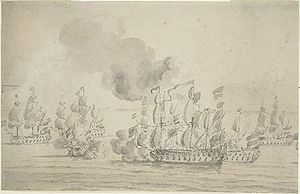HMS Kingfisher (1675)
 HMS Kingfisher's action against seven Algerine ships, 22 May 1681, by Willem van de Velde, the elder | |
| Career (Great Britain) | |
|---|---|
| Name: | HMS Kingfisher |
| Builder: | Phineas Pett III, Woolwich Dockyard |
| Launched: | 1675 |
| Fate: | Broken up, 1728 |
| General characteristics as built[1] | |
| Class and type: | 46-gun fourth-rate ship of the line |
| Tons burthen: | 663 tons (673.6 tonnes) |
| Length: | 110 ft (34 m) (keel) |
| Beam: | 33 ft 8 in (10.26 m) |
| Depth of hold: | 13 ft (4.0 m) |
| Propulsion: | Sails |
| Sail plan: | Full-rigged ship |
| Armament: | 46 guns of various weights of shot |
| General characteristics after 1699 rebuild[2] | |
| Class and type: | 46-54-gun fourth rate ship of the line |
| Tons burthen: | 691 tons (702.1 tonnes) |
| Length: | 125 ft 8 in (38.30 m) (gundeck) |
| Beam: | 34 ft 4½ in (10.5 m) |
| Depth of hold: | 12 ft 9 in (3.89 m) |
| Sail plan: | Full-rigged ship |
| Armament: | 46-54 guns of various weights of shot |
HMS Kingfisher was a 46-gun fourth-rate ship of the line of the Royal Navy, built by Phineas Pett III at Woolwich Dockyard and launched in 1675.[1] She was specially designed to counter the attacks of Algerine corsairs (pirates) in the Mediterranean by masquerading as a merchantman, a ruse which she achieved by hiding her armament behind false bulkheads, and she was provided with various means of changing her appearance. In essence she was the 17th century equivalent of the World War I Q-ship.[citation needed]
Contents
Active service
In 1679, Commander Morgan Kempthorne, the 21-year old son of John Kempthorne, took command of Kingfisher, sailing her to the Mediterranean with a convoy. On May 22, 1681, soon after leaving Naples, Kingfisher encountered seven Algerine ships. The Algerines tried to deceive the English by changing their colours; first they had French, then Dutch and then some of them Algiers colours. One hoisted an English jack and a Turkish or Algerine flag at the main topmasthead. After a sharp fight, the British were able to drive off the Algerines, though Kempthorne died in the action. Including her captain, Kingfisher lost eight dead and 38 wounded in a fight that had lasted 12 hours. The Kingfisher was repaired at Livorno and Kempthorne was buried there.
Three months later, Francis Wheler, formerly captain of Nonsuch, took command of Kingfisher from her lieutenant, Ralph Wrenn, who took command of Nonsuch. In October, Kingfisher fought and captured a large Sallee pirate, which however sank shortly after striking.
In 1685, during the rebellion of Archibald Campbell, 9th Earl of Argyll, against King James, Kingfisher bombarded Carrick Castle, badly damaging the keep, which lost its roof.
Fate
Kingfisher was rebuilt at Woolwich in 1699, as a Fourth Rate of 46-54 guns. She was hulked in 1706, and was broken up in 1728.[2]
Notes
References
- Lavery, Brian (2003) The Ship of the Line - Volume 1: The development of the battlefleet 1650-1850. Conway Maritime Press. ISBN 0-85177-252-8.
| 50px | This article about a ship of the line of the United Kingdom is a stub. You can help Ship Spotting World by expanding it. |
